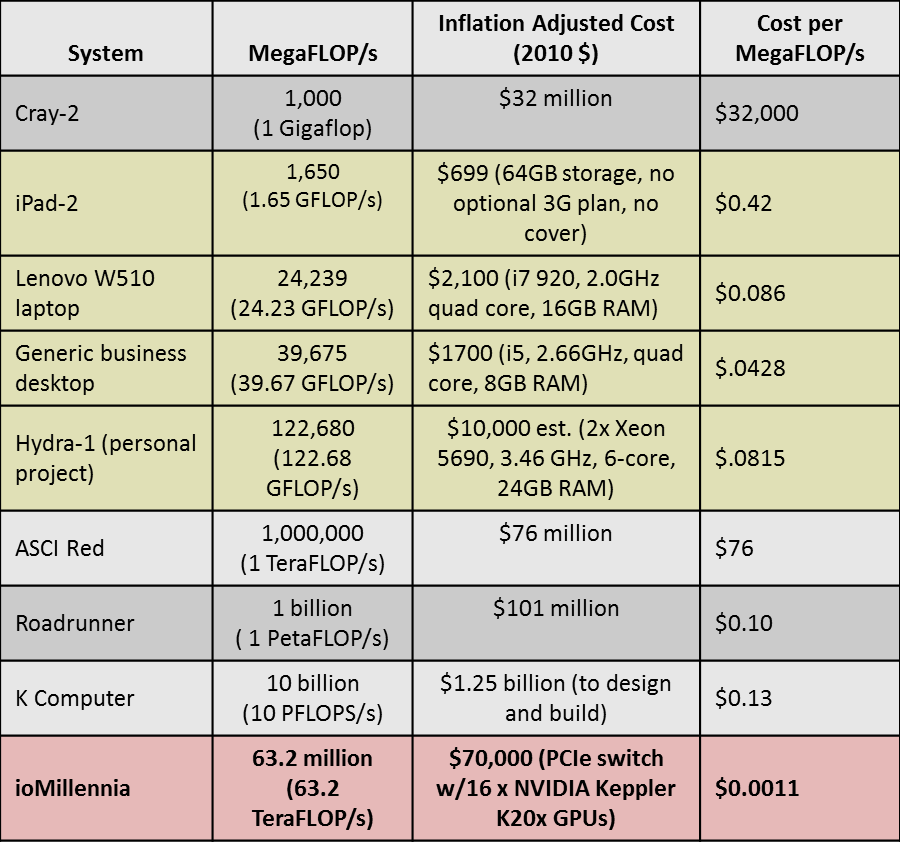If you need lots of compute power, you’re either already using GPU accelerators or taking a close look at them. And if you’re serious about tapping into the full processing power of the GPU, you need to take a look at the newest PCIe switch offering from One Stop Systems.
Dubbed the ioMillennia, it’s a 3U, PCIe Gen3 switch that can handle sixteen full-size GPU cards. We glimpsed this behemoth when walking the floor at GTC 2013 and were attracted like moths to the 42.3 billion candle-power Luxor Sky Beam. (Or, more accurately, like me to a donut display case.)
One Stop Systems VP of Sales Jim Ison walked us through the box, discussing both technical specs and customer usage. It’s quite an achievement, packing 16 hot and power-hungry GPUs into a cramped 3U space. And it does take a little bit of power to run 16 high-performance GPUs – about 6,000 watts provided by three 3,000-watt hot-swappable power supplies. (One is a redundant backup.)
At a retail price of around $15,000 for the base unit, you get a lot of bang for your buck. Let’s do some math. A single NVIDIA K20x has a single precision peak of 3.95 Teraflop/s, and 1.31 Teraflop/s at double precision.
Multiply this by 16 and you get a potential max of over 63 TFLOP/s single precision and over 20 TFLOP/s double precision per 3U rack mount unit. The ioMillennia costs around $18,000 with all four host adapters, and 16 Kepler K20s will cost you an additional $51,200 (16 * $3,200 each). Let’s call it an even $70,000 purchase price. (I’m assuming you already have some fast host systems hanging around).
So, if you have the code to push all 16 Keplers to their peak performance, your price performance would be an astounding $1.11 per Gigaflop/s single precision or $3.34 per GFLOP/s double precision. Why are these numbers astounding?
I wrote an article just over a year ago comparing LINPACK price performance on several supercomputers versus common workstations/home PCs. Getting accurate cost figures on supercomputers isn’t easy; these things don’t come in shrink-wrapped boxes with price tags. However, I think the number I found are at least in the ballpark. Here’s what that chart looks like with One Stop’s ioMillennia added in:

At waaayyyy (technical term, meaning ‘a lot’) under a penny per MegaFLOP/s, the ioMillennia handily beats every system on our chart above – even thrashing my wife’s generic desktop that used to lead the pack at just over 4 cents per MFLOP/s.
Keep in mind that the numbers for the ioMillennia were arrived at by simply adding up the theoretical peaks for all 16 GPUs. It’s not the result of a benchmark or any real-world workload. There also isn’t any host system or other infrastructure cost in that number. However, it’s still orders of magnitude less expensive than other systems in terms of price/performance.
Speaking of performance, the ioMillennia host adapter allows GPUs to directly exchange data without running the request back through the CPU. NVIDIA introduced RDMA (Remote Direct Memory Access) with the Kepler launch last year, but we haven’t seen much real-world data on how well it performs until some sessions at GTC 2013. The advantages can be profound, reducing latency by 5x on large transfers (2MB) and almost 16x on small (16kb) chunks of data. Throughput also rises dramatically. (See TPM’s masterful discussion of RDMA here.)
Check out the video to get a look at the ioMillennia and to hear more details. This product is already available directly from One Stop Systems and should be appearing soon in at least a few major vendor price books.
